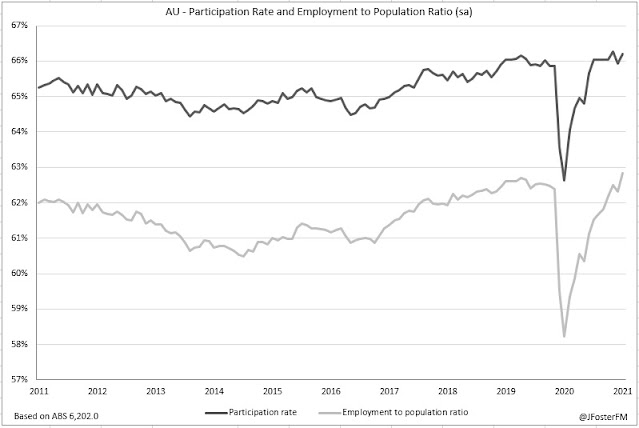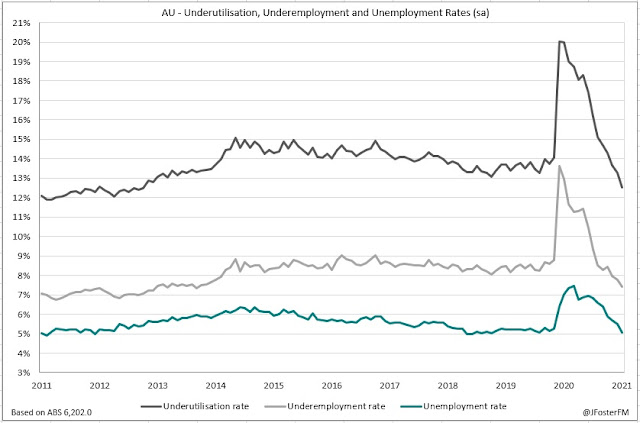Australian labour market conditions have rebounded very strongly in May after a temporary pause in the prior month during the Easter and school holiday period. Employment surged ahead of all expectations printing at a gain of 115.2k in the month, while the unemployment rate fell sharply from 5.5% to 5.1% to be marginally lower than pre-pandemic levels.
Labour Force Survey — May | By the numbers
- Employment (on net) increased by 115.2k in May to soar past the median estimate for a 30.0k rise. The decline in April was revised very slightly to -30.7k from -30.6k.
- National unemployment fell to 5.1% from 5.5% to vastly outperform the consensus estimate for it to hold at that level.
- Labour force participation rebounded from a material fall in April, lifting to 66.2% from 65.9%.
- Hours worked surged up 1.4% for the month to 1.81bn hours (13.0%yr), recovering (and then some) the 0.7% decline in April.
Labour Force Survey — May | The details
Employment surprised markets by falling in April and was largely attributed to seasonal effects from Easter and school holidays through the reference period. There were, however, some questions as to whether the expiry of the JobKeeper wage subsidy had also contributed. It may well have, but the 115.2k surge in employment in May suggests that the greater risk going forward is from COVID outbreaks given the lockdown in Victoria and the very recent emergence of community cases in New South Wales. Full-time employment, which lifted by 33.5k in April, surged by 97.5k to drive the headline increase. Part-time employment only lifted by 17.7k in May after it had plunged by 64.2k in April.
Overall, total employment stands 1.0% higher than at the start of the pandemic, with the full-time segment (+1.1%) now a little higher compared with the rebound in part-time employment (0.7%).
With job vacancies at very high levels, today's survey indicates that supply is meeting that demand. The participation rate bounced back from a sharp fall in April to be around record-high levels at 66.2%. Meanwhile, the employment to population ratio (share of the population aged 15 and over in work) is around the highest levels in the nation's history.
Strong growth in employment is driving down spare capacity in the labour market. Employment at 115.2k in May easily outpaced growth in the labour force (62.2k), resulting in unemployment falling to 701.1k be around where it was at the start of the pandemic. The measured unemployment rate, now at 5.1%, is a little below the 5.3% level from March of last year and this is down from the pandemic peak of 7.5% in July. Underemployment fell from 7.8% to 7.4% and underutilisation declined 0.7ppt to 12.5%, with both measures now at their lowest in more than 7 years.
Growth in hours worked picked up in May, rising by 1.4%m/m, as the disruptions associated with holidays cleared. This was driven by a 1.6% lift in full-time hours as part-time hours rose modestly (0.3%). Overall, total hours worked are a strong 2.9% above their pre-pandemic level: a pace that well exceeds the recovery in employment. The JobKeeper wage subsidy did its job by sparing employment from the depths of decline suffered by hours worked when the restrictions came in and now in this reopening economy, hours worked are expanding in line with the rebound in activity. Those working zero hours due to economic reasons were at a low level in May (58.2k) and in a further positive development from a productivity perspective, average monthly hours were well clear (+1.9%) of pre-pandemic levels.
Turning to the states, gains in employment were concentrated in the largest states rising by 75.2k in New South Wales, 32.3k in Queensland and a 29.8k lift in Victoria. Employment in all states is higher than pre-pandemic, with the strongest recovery occurring in Queensland. Particularly with the wage subsidy now expired, the return to lockdown in Victoria in June will impact that state but it could also have spillover effects in the other states given the declines seen in recent measures of sentiment.
Labour Force Survey — May | Insights
A much stronger-than-expected report today across the key measures of employment, unemployment and hours worked. The strength of the economic recovery is supporting the transitional period in the labour market with the JobKeeper wage subsidy now expired. Forward-looking indicators of labour demand point to further strength in employment, though there are risks here associated with COVID outbreaks with vaccination rates still at low levels. While unemployment is now slightly below its pre-pandemic levels, there is still considerable room for it to decline further, with most estimates of full employment around 4-4.5%.










